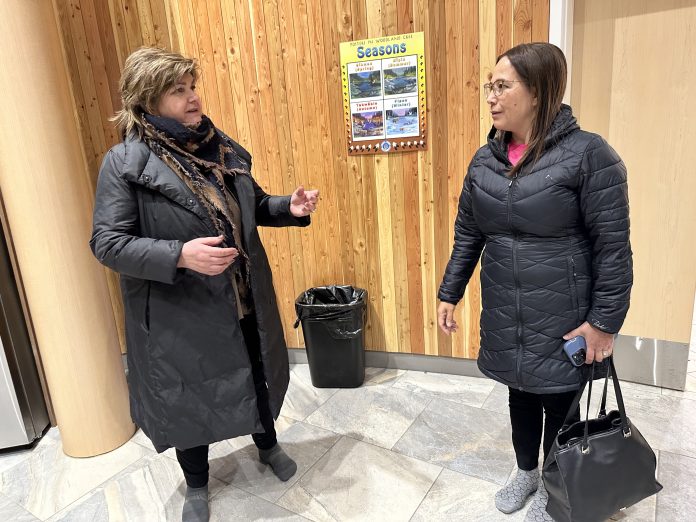
Federal Rural Economic Minister Gudie Hutchings held a news conference in La Ronge at Robertson Trading Thursday, April 6.
Hutchings’ mission – to highlight the 2023 budget investments that will impact Saskatchewan residents.
The highlights include $6.189 billion in Saskatchewan, of a $198.3 billion. “to strengthen Canada’s universal public health care system” and to Saskatchewan “to reduce backlogs, expand access to family health services, ensure provinces and territories and ensure provinces and territories can provide the high-quality and timely health care Canadian’s expect and deserve,” quoted from a federal government news release dated April. 6, 2023.
With this being a non-sitting week, meaning the House of Common’s isn’t in Ottawa, Hutchings is travelling the country making a stop in La Ronge, because “it makes my job easier when I can say I’ve been to northern Saskatchewan,” Hutchings said in an interview with the Northern Advocate.
Being in the area gives her a closer understanding of the challenges and opportunities of the region and a chance to see where federal budget dollars are being spent.
“Today we were here to talk about some of the stuff in the federal budget … there’s a lot in it.”
Hutchings talked about the federal Grocery Rebate that targets low-income families, a top-up on the GST, a rental relief program, a dental plan for Canadians without dental insurance, the reductions of fees banks charge on VISA and MASTERCARD and, in the light of climate change, “greening the economy.”
“We’re giving millions of dollars to help with the healthcare,” she said adding the federal Minister of Health, Jean-Yves Duclos is “working with all the provinces and territories to negotiate this new money that we’re putting out to make sure that it’s going to your areas, where it’s really needed and putting out to make sure that it’s going to really rural and remote and Indigenous communities, where the health care is different … making sure that investments are going to remote and rural areas.”
On the issue of dental care, she said, “O my golly, the dental issue is huge. You know we’re rolling out dental now for people. Nine million Canadians don’t have dental insurance, she said. And, although “there aren’t details now … they’re going to roll it out in a way that, if you don’t have dental insurance, you’ll be able to access dental whether you’re a little child or a senior.”
During the day, Hutchings met with health leaders in the community, visited the La Ronge Health Centre, Northlands College and the Woodland Treatment Centre, meeting with healthcare and education leaders in the community.
In terms of “greening the economy,” Hutchings said, talking with farmers, “they’ll talk about the drought,” with fishers, it’s the impact climate change is having “on the water temperatures. Look at British Columbia, what they had with the droughts and the fires. On the East Coast, where I’m from, last fall we had the largest hurricane to ever hit Canada, so the cost of not addressing climate change, right? So we’re transitioning, having workers transition, the oil sector into hydrogen and wind projects and electric vehicle battery projects … we’ve got to do a better job of protecting Mother Earth and you’d be the first to tell us that, she said, referring to Chief Tammy Cook-Searson of the Lac La Ronge Indian Band (LLRIB).
Cook-Searson accompanied Hutchings throughout the day.
She had the opportunity to talk with second-year mental health and wellness student on the tour.
Questions included, “how do we retain and recruit workers, cause there’s such a high need for workers.”
Training is key, Cook-Searson said. She spoke about the NORTEP/NORPAC and nursing programs that were available to northerners. “I let her know about our Indigenous teacher education program that we have and we’ll be graduating 17 this year.”
Hutchings also had the opportunity to hear from leaders about the challenges of healthcare in northern Saskatchewan including the need for “a lot more services … we’re challenged with geography as well,” Cook-Searson said.
“I suggested that we need more training to train our people for our community members so that they stay in the community.”
With an Indigenous population of more than 80 per cent, having “community members trained” in the areas of LPN, nurses, doctors, dentists and teachers.
Hutchings ended the visit with a tour of the Woodland Wellness Centre.

